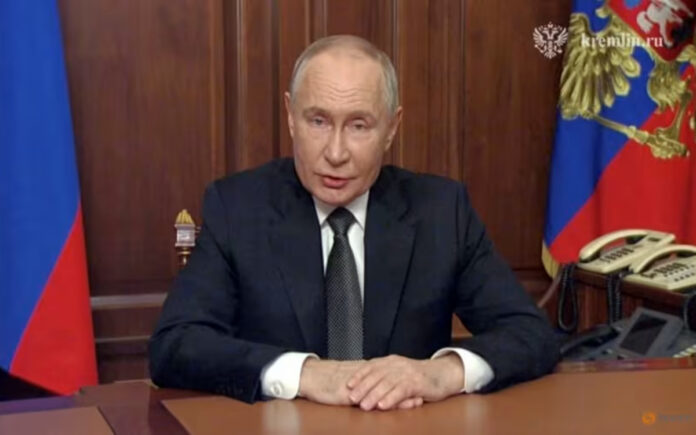Moscow: Russia launched a hypersonic intermediate-range ballistic missile at the Ukrainian city of Dnipro on Thursday, marking a significant escalation in the ongoing conflict. The missile strike came in response to the U.S. and UK permitting Ukraine to target Russian territory with advanced Western weapons, further intensifying the 33-month-long war.
Russian President Vladimir Putin, in a televised address, confirmed the strike on a Ukrainian military facility using the newly developed “Oreshnik” hypersonic missile. Known as the “hazel”, the missile is a medium-range, advanced weapon, and Putin warned that more could follow. He also assured that civilians would be warned in advance of any future strikes involving such weapons.
Following approval from U.S. President Joe Biden’s administration, Ukraine launched six U.S.-made ATACMS missiles into Russian territory on November 19 and continued its strikes on November 21 with British Storm Shadow missiles and U.S.-made HIMARS systems. In his televised speech, Putin characterized this move as a significant shift, claiming that the regional conflict, initially provoked by the West, had now taken on global implications.
Ukrainian President Volodymyr Zelenskiy condemned the use of the new missile, describing it as “a clear and severe escalation” in the war. He called for immediate global condemnation of Russia’s actions. U.S. officials stated that Russia had notified Washington about the missile strike shortly before its launch, with the U.S. briefing Kyiv and its allies on the possibility of such an attack.
Initially, Kyiv speculated that Russia had used an intercontinental ballistic missile (ICBM), a weapon designed for long-range nuclear strikes and previously untested in warfare. However, U.S. officials and NATO sources confirmed that the missile used was an intermediate-range ballistic missile, with a range of 3,000-5,500 km (1,860-3,415 miles).
Tensions between Ukraine and Russia have heightened in recent days. Ukraine’s use of Western-made missiles to strike Russian targets, despite Moscow’s warnings, has significantly escalated the situation. In response to Russia’s missile strike, Zelenskiy called for a stronger global reaction, stating that the lack of a firm international response signals tacit approval of Russia’s actions.
A U.S. official, speaking anonymously, mentioned that Russia likely has only a limited number of the experimental missiles used in the Dnipro strike. The Ukrainian Air Force confirmed that the missile targeted Dnipro in central-eastern Ukraine, fired from Astrakhan, Russia, more than 700 km (435 miles) away.
Fabian Hoffmann, a missile technology expert from Oslo University, explained that the missile’s most significant feature was its MIRVed (multiple independently targetable reentry vehicle) payload, a hallmark of nuclear-capable missiles. He suggested that Russia likely deployed the missile “for signaling purposes” to demonstrate its advanced weaponry.
Also Read | Moscow Uses Upgraded Tu-95MSM Bombers to Hit Ukraine with KH-101 Missiles
In addition to the Oreshnik strike, Russia also launched a Kinzhal hypersonic missile and seven Kh-101 cruise missiles. Six of these missiles were reportedly shot down by Ukrainian air defenses. The strike on Dnipro, which targeted military and industrial infrastructure, resulted in damage to a local enterprise and fires, with at least two people injured. As a result of the security concerns following the attack, Ukraine postponed a scheduled parliamentary session.
NATO spokesperson Farah Dakhlallah condemned the missile strike, stating that Russia’s actions were intended to “terrorize” civilians and intimidate Ukraine’s allies. However, Dakhlallah emphasized that the deployment of such advanced weapons would not change the course of the conflict or deter NATO support for Ukraine.
Also Read | North Korea’s Kim Jong Un Accuses U.S. of Hostile Actions, Raises Nuclear Threat
Military analysts speculated that Russia’s missile launch could be an act of deterrence, signaling its readiness to retaliate after Ukraine’s use of Western weapons in recent days. Russian defense correspondents noted that Ukrainian missiles had targeted the Kursk region of Russia, near the Ukrainian border, using British Storm Shadow cruise missiles. In response, Russia’s air defense systems reportedly shot down two of the incoming Storm Shadows.
The missile strike comes at a critical juncture, just months before President Biden leaves office and President-elect Donald Trump prepares to take office. Trump has expressed a desire to end the war but has not outlined a specific strategy. His critics argue that he may push for peace talks, and both sides are likely jockeying for a strong position ahead of any potential negotiations.



